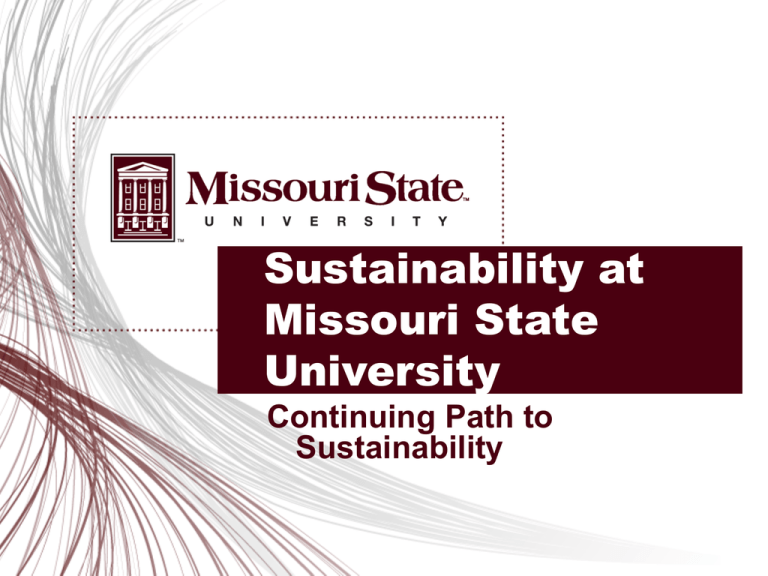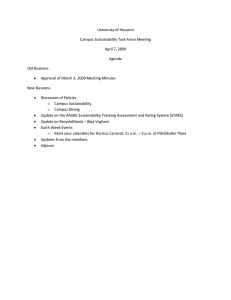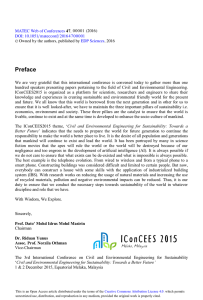sustainability presentation
advertisement

Sustainability at Missouri State University Continuing Path to Sustainability Sustainability • In 1987, the Brundtland Commission of the United Nations defined sustainability as "meeting the needs of the present without compromising the ability of future generations to meet their own needs." • Responsibility for Sustainability • • • • • • • Personal Small group University City State Nation Earth 2 7/1/2016 Sustainability • Sustainability is integrating the environmental, economic and social issues into all decisions of an organization. • The Princeton Review says that 24% of a future students (and 18% of parents) look at our sustainability policies and practices in choosing a college or university to attend. 3 7/1/2016 University Sustainability Statement Missouri State University is committed to environmental sustainability and stewardship. By working to create a cleaner environment through community service efforts, the application of earth-friendly technology and practices, research projects, and responsible development planning, we will strive to work for a better tomorrow. Through education and community outreach, we will provide students with the knowledge and skills to be environmentally responsible citizens and consider the global ramifications of their actions and the actions of others around them. To that end, Missouri State University is committed to continuous improvement in: • Incorporation of environmentally responsible concerns in University decision making. • Demonstration of institutional practices that promote sustainability, including energy savings measures, increasing the use of renewable resources, and decreasing production of waste materials. • Providing educational programs and encouraging environmental inquiry for students and the community concerning positive environmental practices. • Establishment of sustainability indicators to enable monitoring, reporting and improvement measures. • Enhancing the health of campus ecosystems and increasing the diversity of native species whenever possible. • Promotion of health, productivity and safety practices on campus through education, maintenance and design of campus buildings. Our decisions and actions will be guided by the University's Public Affairs Mission, will be reflective of the University's resources, and informed by the University's Strategic Plan. As a learning institution, we recognize that planning for sustainability will be an evolving and iterative practice. 4 7/1/2016 Sustainability • Sustainability Advisory Committee • Tammy Jahnke, Co-Chair • Ken McClure, CoChair • Janice Greene • Anson Elliott • Bill Cheek • Jen Cox • Jeff Brown • David Vaughan • Bob Eckels • Vickie Younger • Doug Sampson • Brad Kielhofner • Holly Niell • • • • • • • • Shelly Duran Barbara Lucks Mike Kromrey Earle Doman Debbie Letterman Nicki Donnelson Mike Wills Carolyn Mayer 5 • Charge • Celebrate the successes related to sustainability initiatives and articulate our commitment to the future. • Identify ways to inform the campus community, Springfield community, Missouri and beyond what Missouri State is doing related to sustainability. • Use the university’s current sustainability statement to frame our path. 7/1/2016 Sustainability • Environmental Focus Committee – • Chair - Melida Gutierrez (through 2010) • Pam Sailors (through 2010) • Mark Rushefsky (through 2010) • Brian Greene (through 2010) • Carol Miller (through 2011) • Alexander Wait (through 2011) • Roberta Aram (through 2012) • Lora Vess (through 2012) • Pawan Kahol, ex officio • 6 Charge – • To identify ways through the curriculum and specific classes (credit and non-credit) to raise the consciousness of the campus and the surrounding community regarding significant environmental issues. To advise in matters of curriculum for the interdisciplinary environmental sciences and policy minor. In particular, this year I would like for the committee to investigate certificate or MS degree programs to address sustainability issues. A summary report of the committee’s work is to be submitted to the CNAS Dean at the end of the academic year. 7/1/2016 Sustainability Student Organizations • Students for a Sustainable Future • Sierra Club • Association of Civically Engaged Students • Student Community Action Team • SGA Director of Sustainability (Cabinet level position with SGA) • And many others 7 7/1/2016 Sustainability • Green Lunches – Alexander Wait/Lora Vess • Study Away Opportunities • Specific Courses 8 7/1/2016 Sustainability – Reasons to Celebrate • Incorporation of environmentally responsible concerns in University decision making. • University Committee (Sustainability Advisory Committee) to address sustainability statement. • New campus recreation center and Phase III of Darr Agriculture Center will meet LEED certification standards. • Committee formed and charged with submitting curricular changes related to sustainability. (Environmental Focus Committee) • Energy/water conservation • Hired Energy Manager – promotes additional energy savings • Boiler plant efficiency upgrade completed in 2008 which reduces natural gas consumption. 9 7/1/2016 Campus Recreation Center 10 7/1/2016 Darr Agricultural Center – Phase III 12 7/1/2016 Darr Agricultural Center – Phase III 13 7/1/2016 Energy • In 1996 MSU made $5.5M of Energy Improvements • Light upgrades – Central Energy Mgmt System – metered buildings • Improvements paid for themselves in 7.3 yrs • In 2004 MSU installed $10.9M Chilled Water Loop • Shares Chilled Water between 20 major buildings • Replaces 16 old & inefficient chillers • To pay off by 2017 • Benefits • $15M of Total Energy Savings since 1996 • Opportunities to reinvest and save more • Environmental Impact – Reduced CO2 emissions by more than 180,000 tons, Nitrous Oxide by 780 tons and Sulfur Dioxide by 380 tons. 14 7/1/2016 Water Conservation • Installed 3 Synthetic Football/Soccer Fields • Eliminated major water consumers • Irrigation Systems • Timers reduce water usage • City Utilities Alternate-Day-Program in place • Conversion to water-efficient restroom fixtures • Rain barrel Initiative • To recycle old, but clean, underground fuel tanks 15 7/1/2016 A Commitment to the Future • Incorporation of environmentally responsible concerns in University decision making. • MSU is investigating the possibility of LEED certification for current buildings. • No statements on Facilities Management website indicating sustainable practices. • No statements on Procurement website indicating sustainable policies or practices. • Exploring • • • • New lighting technology (including LEDs) Occupancy Sensors Improving efficiency & capacity of Chilled Water System Solar Energy 16 7/1/2016 Sustainability – Reasons to Celebrate • Demonstration of institutional practices that promote sustainability • Sodexo • All disposable paper products removed from dining halls • Napkins and packaging materials are now biodegradable. • All cleaning supplies are green. • Since January 2009 150,000 lbs of food waste has been composted. • Not running garbage disposal – saved 1.4 million gallons of water since January 2009 and much electricity • University uses several electric vehicles. • Students limit printing quota on campus. • Recycling - batteries, e-waste, and toner cartridges • Trial recycling during spring 2009 – 1600 lbs of of plastic/aluminum collected in Temple and Glass Halls . 17 7/1/2016 Food Waste from Dining Hall 18 7/1/2016 More Food Waste from Dining Hall 19 7/1/2016 Residence Halls • Residence Halls • • • • • • • • • Energy Conservation Task Force Energy Star replacements for refrigerators. Low flow aerators used for sinks and showers in all renovations. Computer labs in residence halls print double sided only – saved 750,000 sheets of paper last year. Occupancy sensors installed in common areas such as bathrooms, laundry rooms, and study lounges. Saves $7K annually. Green cleaning products used when possible. Battery recycling at all front desks. Plastic bag recycling in the lobbies. Participation in RecycleMania. 20 7/1/2016 Residence Life Energy Competition Electrical Consumption - October kWh's 2006 2007 2006 - 2007 2008 FY07 FY08 Average FY09 Reduction in kWh 2008 Change from 2006 2007 average Cost Savings from 2006 - 2007 Average Elect Occupancy 10.17.08 Consumption - FY08 Elec Cost Blair-Shannon 239,317 247,048 243,183 215,699 27,484 -11% $1,572.06 703 Freudenberger 144,867 159,083 151,975 153,504 -1,529 1% -$87.46 693 Hammons & Hutchens 271,276 263,053 267,165 264,435 2,730 -1% $156.13 555 540(U) Reduction per Resident $2.24 kWh reduction per resident 39.09459459 -0.126203175 -2.206349206 4.918018018 Kentwood Hall 71,100 96,000 83,550 92,100 -8,550 10% -$489.06 116 Scholars 44,960 48,960 46,960 40,160 6,800 -14% $388.96 112 3.472857143 60.71428571 Sunvilla Tower 91,200 105,600 98,400 92,400 6,000 -6% $343.20 228 1.505263158 26.31578947 Dogwood Apartments 20,800 23,520 22,160 22,880 -720 3% -$41.18 61 -$0.68 -11.80327869 132,284 136,472 134,378 115,287 19,091 -14% $1,092.01 473 $2.31 40.3615222 75,953 73,989 1,964 -3% $112.34 352 $0.32 5.579545455 Wells Woods 76,579 75,327 53,269 $3,046.99 3293 -4.216034483 -73.70689655 Recyclemania Bulletin Boards Educational Programming: Sustainability Program Count: 75 Total Attendance: 7,127 Average attendance per Program: 95.03 http://rlsapps/programming/SustainabilityReport.php Creative Programs include: -No Power Hour -Race to Recycle -Trash to Treasure -Woods Without Lights Wednesdays -Project Greenway -Hybrid Car Show - Adopt-A-Street: Cleaning and Greening our Earth - RHA is seeking funding for a Green Bike Program Programming Resources: -Books on sustainability -Presentations: Resident Assistants, the Residence Hall Association General Assembly, RA programs for residents - Demonstrate creative ways to make door decorations and publicity sustainably Creative Publicity: -Wells used post-consumer goods for publicity (ex. bed sheets, old posters, etc.) & swapped decorations between RAs -Digital picture frame with publicity for upcoming programs -Laminated signs that will be used from year to year -Used e-mail and facebook Second Annual Project Greenway Hall Councils and RAs were dressed in recycled materials to show how creative and sustainable their building could be. Students designed their outfits around a theme which they chose as a group. A Commitment to the Future • Demonstration of institutional practices that promote sustainability • Recycling – Campus-wide (Goal – January 2010) • Faculty Senate has new ad hoc committee to review paper usage. • Sustainability website needs links to all policies/procedures. • University-wide participation in RecycleMania. 27 7/1/2016 Sustainability – Reasons to Celebrate • Providing educational programs and encouraging environmental inquiry • Carbon sequestration research project with CU • Bull Shoals Field Station activities including GLADE • Missouri State is state-wide coordinator for Project WET • State Coordinator for Project Leopold – Dr. Janice Greene • Center for Resource Planning and Management – Sustainable development in southwest Missouri • OEWRI – Ozarks Environment and Water Resources Institute • Environmental Science and Policy Minor • ONE Conference and Focus the Nation and Earth Day Events • Marketing project on public transportation - COBA • Residence Life Sustainability Guide 28 7/1/2016 A Commitment to the Future • Providing educational programs and encouraging environmental inquiry • Future certificate and/or degree programs • Water/rain garden at corner of Grand/National. 29 7/1/2016 Sustainability – Reasons to Celebrate • Establishment of sustainability indicators • Data is available on electricity, natural gas and water usage. • University-wide • Residence Hall Competition • Preliminary recycling data is available. 30 7/1/2016 Benefits City Utilities Top 10 Natural Gas Consumers Missouri State Customer 1 University #1 – #2 – #3 – #4 – Customer 2 Customer 3 Missouri State University Customer 5 Customer 6 Customer 7 Customer 8 Customer 9 Customer 10 Energy Facilities Management Benefits Environmental Impact Over 13 POLLUTION REDUCTION: Years The volume which could fill: Carbon Dioxide Nitrous Oxide (Acid Rain) 180,000 Tons 780 Tons 13,205 Goodyear Blimps 57 Goodyear Blimps 27 Sulfur Dioxide Energy 380 Tons Goodyear Blimps Facilities Management FY09 ACHIEVEMENTS $7,000,000.00 What Would Have Been Actual Cost $6,000,000.00 $5,000,000.00 $4,000,000.00 $3,000,000.00 $2,000,000.00 $1,000,000.00 2009 2008 2007 2006 2005 2004 2003 2002 2001 2000 1999 1998 1997 $0.00 Total Energy Cost Avoided: $15M ENERGY MANAGEMENT A Commitment to the Future • Establishment of sustainability indicators • Specific goals will be clearly articulated. 34 7/1/2016 Sustainability – Reasons to Celebrate • Enhancing the health of campus ecosystems • Tree management program established. • Water Garden on the Mountain Grove Campus • Some of grounds crew went through "Show-Me Yards and Neighbors" training 35 7/1/2016 FY09 ACHIEVEMENTS nd 2 Year of Reforestation Historic Quad Fall 2008 – Spring 2009 Planted six (6) London Planes Reforestation REFORESTATION – LONDON PLANES FY09 ACHIEVEMENTS Reforestation Phase II REFORESTATION – LONDON PLANES A Commitment to the Future • Enhancing the health of campus ecosystems • Interest in “Show-Me Yards and Neighbors” Certification 38 7/1/2016 Sustainability – Reasons to Celebrate • Promotion of health, productivity and safety practices • November 18 Sustainability Event • Sustainability Website http://www.missouristate.edu/sustainability/ 39 7/1/2016 A Commitment to the Future • Promotion of health, productivity and safety practices • Regular updates are communicated to MSU community. 40 7/1/2016 To that end, Missouri State University is committed to continuous improvement in: • Incorporation of environmentally responsible concerns in University decision making. • Demonstration of institutional practices that promote sustainability, including energy savings measures, increasing the use of renewable resources, and decreasing production of waste materials. • Providing educational programs and encouraging environmental inquiry for students and the community concerning positive environmental practices. • Establishment of sustainability indicators to enable monitoring, reporting and improvement measures. • Enhancing the health of campus ecosystems and increasing the diversity of native species whenever possible. • Promotion of health, productivity and safety practices on campus through education, maintenance and design of campus buildings. Our decisions and actions will be guided by the University's Public Affairs Mission, will be reflective of the University's resources, and informed by the University's Strategic Plan. As a learning institution, we recognize that planning for sustainability will be an evolving and iterative practice. 41 7/1/2016



